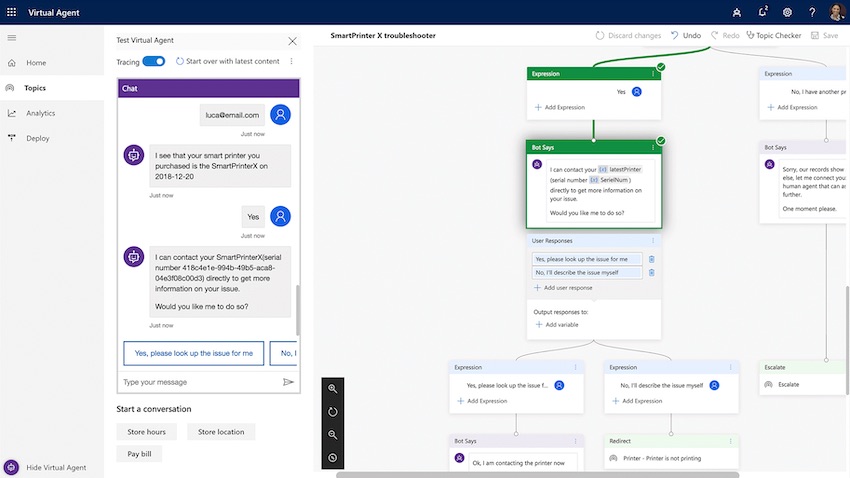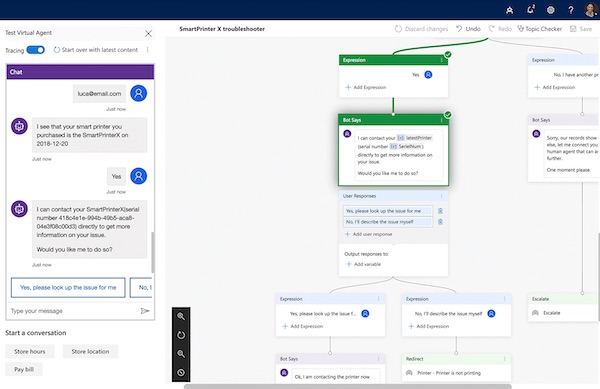Microsoft Power Virtual Agents is Bot Building for Anyone, That is Anyone Building for Enterprise Customer Service
“We want every company out there to be a tech company in its own right,” said Satya Nadella, CEO of Microsoft Corporation, during the Ignite developer conference keynote this week. One way Microsoft hopes to enable this vision is by providing an easy way for anyone, even people without software development experience, to build an AI bot. The new solution is called Power Virtual Agents (PVA).
Power Virtual Agents empowers customer service teams to easily create powerful bots using a guided, no-code graphical interface without the need for data scientists or developers.
It includes what you would expect of a tool for non-developers. There is a visual, drag-and-drop interface for building out process flows and forms where you can add text or logic. A real-time simulator enables users to test their creations. The idea here is to remove the mystique of chatbots that at one-time required data scientists and machine learning experts to build your own and later became accessible to experienced developers. Microsoft is attempting to package the process up so any subject matter expert can build a bot.

It’s Not a Shortcut Today, But An Idea Toward Microsoft’s Vision
PVA is in a beta release and comes with a number of limitations. First, you have to have a work email that is managed by some other Microsoft product. You are steered toward a Microsoft Dynamics login but if you use Office 365 that will get you in as well.
When you create your first bot, you will quickly learn that the builder is really limited to customer service use cases today. And, aside from the hardcoded (well, not code, but specifically defined) responses that you will enter into the bot, you can today only support four variables. These include text (string), age, currency, and number. If you want to do anything with an existing knowledge base you will likely be back to some actual coding. The are many pre-built connections and the Power Automate solution, in theory, enables non-developers to complete these workflows, but several of the steps will be trivial for developers and not intuitive for others.
We have seen these evolutions before. Amazon released the Alexa SDK, a number of partners launched visual flow builders to make skill development accessible to designers and writers, and then Alexa Skill Blueprints made it even easier with pre-built forms that anyone could use. Google rolled out Actions on Google, then Dialogflow, followed by support from some third-party visual flow builders, and in the mean-time began offering templates for common voice app use cases. Samsung launched Bixby Developer Studio in November 2018 followed by Bixby Capsule Templates in October 2019. Microsoft Bot Framework enables developer-led bot building and PVA will provide a way for non-developers to certainly design and test solutions and in some cases deploy to a website.
A No-Code Complement to Bot Framework
All of these moves intend to reduce the burden on developers while also hoping to eliminate them as a bottleneck. This may work for some simple consumer-oriented bots, but in the enterprise, customization is often critical. These tools are more likely to become a way for designers to create bots that can serve as a reference and requirements baseline that developers can then replicate in custom code while adding features the visual builder will not accommodate. This is precisely how Adobe saw this playing out for big companies when it decided to acquire Sayspring in 2017.
Microsoft already offers one of the most popular bot building solutions, Microsoft Bot Framework. And, indeed if you want to customize and add more features to your Power Virtual Agent, you can do so using Bot Framework. PVA is built on top of it.
You Still Need a Design…and Designers
Just because anyone can build a basic bot with PVA doesn’t mean that just anyone should. For these to really work you still need to create a design and not everyone has that experience. Requirements analysis, process flow mapping, and user experience design all exist for a reason. So, a subject matter expert may be able to understand the content required for a bot to perform and even the main process flow, but they often will not understand the basics of user experience design and what happens when users refuse to follow the “happy path.”
With that said, when you have a design, PVA will enable non-technical staff to quickly prototype and update the bot functionality. Some of these may eventually be “user-ready” and deployed into production, but many are likely to go through a cycle of updating and extension by software developers.
Bots for Enterprise Processes
PVA is designed for enterprise chatbots for customer service today. However, you can see how this will quickly move into handling internal process automation as well. In fact, that is likely where PVA will have the biggest impact. There are many bot building solutions for customer service, often offered by contact center software providers. Tight integration with contact center software will bring other benefits that few standalone bots will be able to match.
However, there are fewer options for automating internal processes that are flexible, accessible, and extensible. Microsoft indicated that PVA will expand beyond customer service in the future. Look for it to support internal processes such as HR, Finance, and Sales next. And, you can also assume that voice will be integrated into future releases so Cortana can enable spoken conversation to complement the typing.
Follow @bretkinsella Follow @voicebotai
Microsoft’s Cortana Strategy Makes Sense for Them in a Way That it Wouldn’t for Amazon or Google
Microsoft’s $249 Earbuds Want to Put the Office in Your Ears









